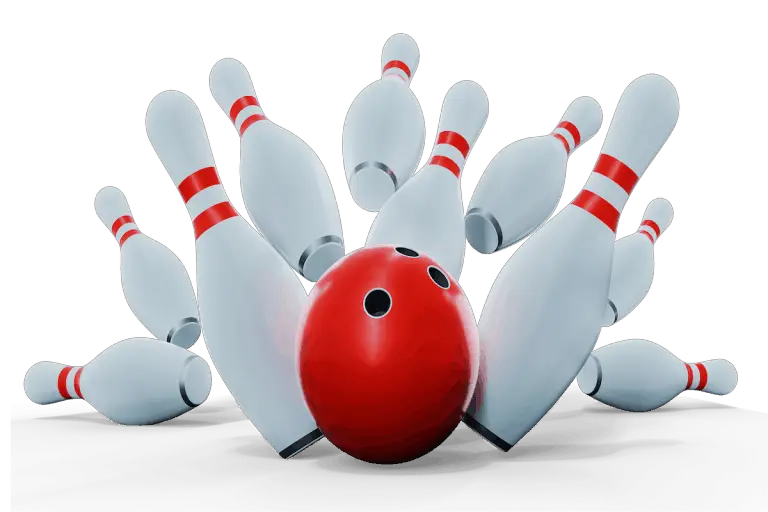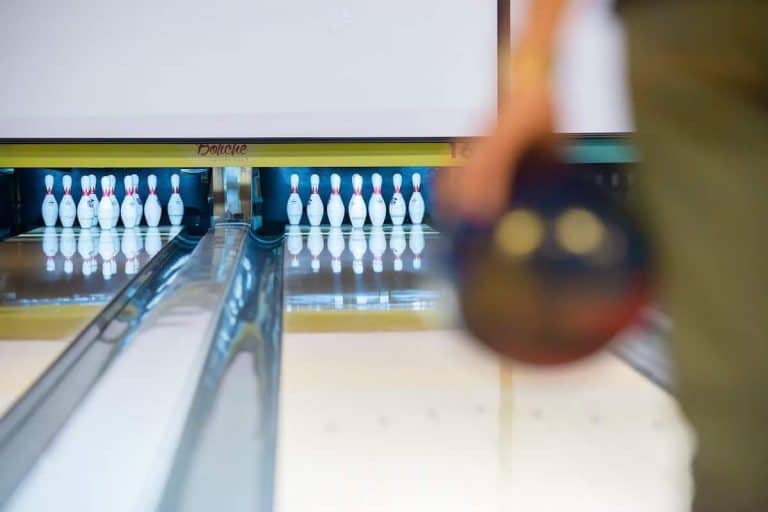Are Heavier or Lighter Bowling Balls Better?
If you’re in the market to buy a bowling ball, you’ve probably encountered the importance of ball weight. It’s intuitive that you’ll have more control with a lightweight ball, but heavier balls are better for bowling a strike. With that in mind, how do you know which you should get?
Heavier bowling balls are better for hooking and getting a good swing, but a lighter bowling ball is easier to roll, and they offer better control. It is recommended that beginners should use a lightweight ball to get a feel for it, moving up when they’re more comfortable with aiming for a strike.
Throughout this article, you’ll also learn the following information about choosing the weight of a bowling ball:
- Advantages and disadvantages to heavyweight and lightweight balls
- What you need to look for when choosing either of them
- Extra considerations and answers to the most common questions
Pros and Cons of Heavy Bowling Balls
Bowling balls are heavy by nature. They need to be able to gain momentum as they roll down the lane, but that doesn’t mean that they have to be overwhelmingly big. If you’re considering a heavyweight bowling ball, you’ll be glad to know that they’re quite powerful and an excellent choice for advanced players.
Here are the pros and cons of heavy bowling balls:
Pros of Heavy Bowling Balls
- Heavy bowling balls have a better chance of getting a strike. Since they have more weight behind them, you’ll increase the chances of knocking down more pins. If you’re a go-getter who wants to get a strike on every shot, then you’ll enjoy this aspect of heavyweight bowling balls.
- It’s much easier to hook a heavy bowling ball since it pulls itself along. As mentioned above, the angular momentum increases as the ball continues to roll. Those who want to go with trick shots or who are trying to knock over the last few pins would do better with one of them.
- It prevents deflection from ruining your shot. Heavy bowling balls don’t vary their course as much. They stick to the trajectory that they’re going when you let go of the ball. This factor can work for or against you, so feel free to get a middleweight ball.
- Swinging the bowling ball is much easier when you’re able to take advantage of the weight. Heavy bowling balls roll with your arm and hands. As long as you’re able to maintain a good posture as you swing the bowling ball, it’ll roll perfectly. It’s one of the many reasons that experts choose heavy balls.
Cons of Heavy Bowling Balls
- If you have muscle or joint issues, then a heavy bowling ball should be out of the question. They move with your arm as you read above, so it can hurt your shoulder, elbow, or wrist. Again, proper posture can make a world of difference, but the room for error is much greater with a heavyweight ball.
- Unfortunately, heavy bowling balls don’t move much on their own. If you don’t put enough strength behind it, the ball might not even make it to the pins. Furthermore, a slight mistake can shoot it straight into the side lanes. It’s important to focus on every movement when you use these balls.
It’s up to you to decide whether or not the pros outweigh the cons of heavy bowling balls. You might like the higher chances of getting a strike, but without good form, you’re bound to hit the side lanes. Before you make a decision, let’s analyze the same information as it relates to lightweight bowling balls in the next section.
Should You Get a Light Bowling Ball?
Now that you’ve seen everything there is to know about heavyweight bowling balls, it’s time to discover the other side of the coin. You’ve hopefully seen that many people recommend that beginners use lightweight bowling balls. There are plenty of reasons for that, but it’s also crucial that you know the disadvantages.
Here are the pros and cons of lightweight bowling balls:
Pros of Lightweight Bowling Balls
- One of the biggest reasons that so many people choose lightweight bowling balls is that they’re easier to control. You can choose the trajectory by flicking your arm in any direction. They’re much more susceptible to changing directions, so be careful when you’re bowling with them.
- Bowling Ball explains that bowling with a lightweight ball feels much smoother than its heavyweight counterpart. You don’t have to deal with the awkward thud or uncomfortably swing if you’re not used to bowling. Furthermore, you don’t have to worry about muscle or joint pain.
- You don’t need much skill to use a lightweight bowling ball. If you’re a beginner, then the lightweight nature of these types of bowling balls will allow you to control the whole process and learn the ropes. There’s no need to focus on the technical aspects of bowling when you’re figuring it out.
- You can make last-second adjustments. Whether you want to create a sharp hook or slide it super fast to the last pin, a lightweight bowling ball reacts to every subtle movement that you make. You can put a spin on it to reduce the speed or shoot straight down the center for a quick strike attempt.
Cons of Lightweight Bowling Balls
- Speaking of strike, lightweight bowling balls lower your chances of getting one. Why so? Because you don’t have the same weight behind it as a heavyweight bowling ball. It’ll knock over the pins that it hits without a problem, but the ripple effect isn’t as great as it would be with a bigger ball.
- As you saw above, every move that you make alters the trajectory of a lightweight bowling ball. If you flinch at the last second or flick your wrist, it can change the speed, course, and more. Furthermore, lightweight bowling balls bounce much more because they’re not tethered to the ground.
Ultimately, it’s worth comparing lightweight and heavyweight bowling balls, regardless of your experience level. The best way to know which one you should get is to go to a local bowling center and try both of them. If you don’t have that option at your disposal, head to the next subheading to find out the differences.
What’s the Difference Between These Options?
You already know the pros and cons of both options, but if you’re still on the fence, this is the section for you. There are numerous differences between light and heavy bowling balls. You’d be surprised to learn how big of an impact a few pounds can make, especially if you’re an inexperienced bowler.
Consider these differences before making your final decision:
- Heavyweight bowling balls are typically more expensive. More materials and a longer creation process cause companies to drive up the price. However, you shouldn’t expect to spend more than a few dollars extra. Note that the brand has a greater impact on the price than the weight.
- Lightweight bowling balls offer more control while sacrificing effectiveness. If you’re tempted to get a lightweight ball because you’re not a professional bowler, you should know that you won’t have the same splash effect as a big ball. You might be able to get a strike here and there, but not every time.
- If you’re not used to bowling, a lightweight ball might be the best choice. The control that you gain by shaving off a couple of pounds from the ball is undeniable. You can take it slow and forget about bounces and striking if you’re able to relax and take your time.
- Youth leagues almost always use lightweight balls. If you’re getting a bowling ball for a youth player, then you should stick with lightweight bowling balls between 6 to 9 pounds. The weight requirements can differ between leagues, so make sure you ask for more details before getting one.
- The manufacturer can make a massive difference. Some manufacturers have wider holes for the player’s fingers, whereas others have higher density. The manufacturer can’t be overlooked when you’re choosing the weight of a bowling ball. There are plenty of considerations other than the weight.
The differences might seem insignificant if you’ve been bowling for a while, but there’s no doubt that a beginner or an experienced bowler would feel more or less weight. If you’re skeptical, purchase an 8-pound ball and a 16-pound ball and see how different it feels. For more factors to think about, read on.
Additional Considerations When Choosing a Bowling Ball
The weight is a huge part of choosing a bowling ball, but it’s not the only thing that you need to think about. After all, you could get the perfect weight and a horrible brand. The result could be scratches, chunks missing, small finger holes, or an ugly appearance. Let’s break down a handful of considerations that you should make when purchasing a bowling ball in these points:
- Remember to choose a high-quality brand. Bowling.com shows us that the brand is enough to make or break your bowling experience. If you aim for a low-cost company, you’ll get what you pay for. There might be chips, scratches, and other issues that threaten the integrity of the bowling ball.
- Don’t forget about the drilled holes. There are several different sizes to consider when you’re buying a bowling ball, but you can’t overlook the dimensions of the holes. They need to be big enough to prevent your fingers from getting stuck but snug enough that they don’t slide around when you’re rolling the ball.
- Consider the color and pattern of the bowling ball. Although it doesn’t impact the performance of the ball, it doesn’t hurt to check out the cosmetic features. Bowling balls have changed to come in all sorts of colors and unique patterns thanks to countless artists and machines. Find one that matches your style.
- Set a reasonable budget and stick with it. If you want to make sure you don’t spend too much, make up a price and give it a little bit of wiggle room. As stated by Bowling 2 U, a decent bowling ball costs between $50 to $100 or more. It might sound like a lot, but you’ll be glad to know that they last for a long time.
When you know everything to consider, you’ll be able to find the perfect bowling ball that fits your style (cosmetic and playstyle, of course). There’s not much else to a bowling ball, which makes it a low-cost sport for a lot of beginners. If you want to know what can alter the weight of the ball, you’ll find out below.
What Affects the Weight?
You might know why the weight matters and everything else that you need to consider when buying a bowling ball, but many bowlers want to know why. Why does the weight change from one ball to another? It’s much simpler than you might think, but knowledge is power, so let’s dive into the various factors.
Here are the three things that change the weight of a bowling ball:
- The material composition is worth mentioning when you’re thinking about the weight of a bowling ball. Some bowling balls are made with different materials, though the vast majority of them use urethane, plastic, resin, and a few other materials (Source: Bowlers Advantage). Lighter materials reduce the weight, but they cut the durability, too.
- The size of the drilled holes can change it by a few ounces. Bigger gripping holes cut down on the materials used in the bowling ball. Needless to say, fewer materials equates to less weight. Remember that the holes are incredibly important due to comfort purposes. Consider the holes first, followed by the weight (unless you’re competing and have a weight requirement).
The weight of the bowling ball is of utmost importance in high-level competition. Even in youth games, there’s a set bowling ball weight limit that can’t be exceeded. Try your best to enjoy several rounds without the pressure of competition. Use various sizes and weights to know what you can comfortably bowl with.
FAQ
Bowling is a very complex sport despite the fact that there are only a few requirements. All you need is a ball, a set of pins, and a lane. However, it’s easy to understand why a beginner might be confused when they’re trying to choose one of the three components. If you’re in that group of people, rest assured knowing that the final details are explained on this page.
How Can You Choose a Bowling Ball?
You should factor in the weight, size, color, drill-hole size, and most importantly, comfort. If you’re ordering a ball online, it might be difficult to know how it’ll feel when you hold it. Check out customer reviews and find out what they’re saying. Remember that the size of your hand, as well as which side is your dominant hand, will matter.
Is the Weight of a Ball a Big Deal?
The weight of a bowling ball matters for the following three reasons:
- It impacts how you control the ball. As you’ve read throughout this article, a heavy ball can knock a strike, but it doesn’t offer the same level of control as a lightweight bowling ball.
- It changes the way you release the ball. If you’re not careful, you might bounce the ball or send it rolling into one of the side lanes.
- Many leagues have specific weight requirements. Check the rules of the league that you intend to join before you purchase a bowling ball.
What Are the Dimensions?
There are many different weights and types of bowling balls. The average bowling ball is about 8.5 inches diameter. Keep in mind that it’s nearly impossible to make a perfectly round ball (out of any material), so there might be a slight deviation from that measurement.
Conclusion
Whether you choose a light or heavy bowling ball, every movement counts. Try to focus your energy on perfecting your form and each motion rather than worrying about the ball. After all, every sport is determined by the skill of the player with a slight alteration based on the weight of the ball, disk, or puck.
Here’s a quick rundown of the post:
- Heavy bowling balls are the better choice if you want to shoot for strikes.
- Light bowling balls offer the comfort and speed that beginners search for.
- A heavyweight bowling ball is less likely to bounce if you mess up.







